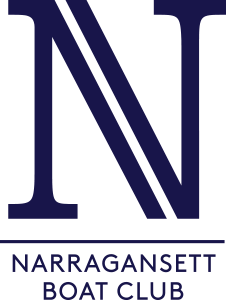History of Narragansett Boat Club
Compiled by Albin Moser
In 1838, George C. Nightingale, William A. Greene, Rufus Waterman, Henry Lippitt, Sullivan Dorr, Jr., William C. Allen, and Charles Arnold were among the influential men of Providence who founded the Narragansett Boat Club. Following the Civil War, the Club constructed an impressive boathouse on the banks of the Seekonk, almost at the junction of what are now Angel Street and River Road. This impressive two-story structure not only sheltered a large flotilla of boats, it also contained a large meeting room and changing rooms. For many years this boathouse served as a gathering spot for the social elite of Providence. Throughout the 1880’s, the Narragansett Boat Club spawned many national champions and sponsored a professional sculling regatta that was featured on the cover of Harper’s Magazine. Thus, as the 19th century matured, so did the Narragansett Boat Club. It became a premier social and athletic organization of Providence’s East Side.
With the onset of the 20th century, a new phase of American life brought changes to the Narragansett Boat Club. Changes in sports fads, the two World Wars, and the economic catastrophe of the Depression brought a significant decrease to the Club’s membership. In 1938, the Club moved into a newly-built, but much smaller boathouse on River Road. They had sold the larger structure to Brown University. During that period of time, the efforts of Charles B. Malone were instrumental in the Narragansett Boat Club’s survival. During the late 1940’s the Club was also the first home of the modern-day Brown University Rowing Program. From 1949 to 1967, the Brown University Crew leased space within the Narragansett Boat Club Boathouse. In October of 1967, the Brown Crew rowed its shells south to the Hunter S. Marston Boathouse on India Point.
In the 1960’s, businessmen Avery Seamen, Bill Makepeace, Charlie Williamson, and others redirected the club’s energies toward recreational and social rowing. Their leadership during this period kept the club alive as a viable organization. They also attracted a stable and supportive membership composed of older, established rowers who had a stake in Providence. The membership base grew to more than seventy. Within this group twenty to thirty members rowed more than three times a week.
In 1971, the Narragansett Boat Club entered its most active phase of the 20th century. At the suggestion of Albin Moser and under his direction, the Club initiated a learn-to-row sculling program. Although originally focused on developing teen age boys as competitive scullers, this program soon included girls, men and women. The club’s membership has now increased to an annual average of nearly 200. The rowing program is open to the general public. Program participants usually approach two hundred persons rowing two to four days a week. As a testimony to its success, the rowing program has become an institution at the Boat Club.
As a result of the growth of the rowing program and the growth of the Narragansett Boat Club as an organization, those who are active rowers has also markedly increased. Many of our members actively row three or more times a week. The total mileage accumulated by members of the club now averages 80,000 miles annually. In 2014 the cumulative mileage total for the club reached 86,738!
In addition to doing a great deal of rowing on the Seekonk and Providence Rivers, the club has developed regional, national, and world-level rowers in youth, elite, and masters (age 27 and older) programs. As a further statement supporting the life and activity of our Club, we have steadily purchased many new shells and, in 1992, we expanded the boathouse with a new fifty-five foot addition. We now have more shells in our building than what was owned by the club in the height of rowing popularity of the nineteenth century.
